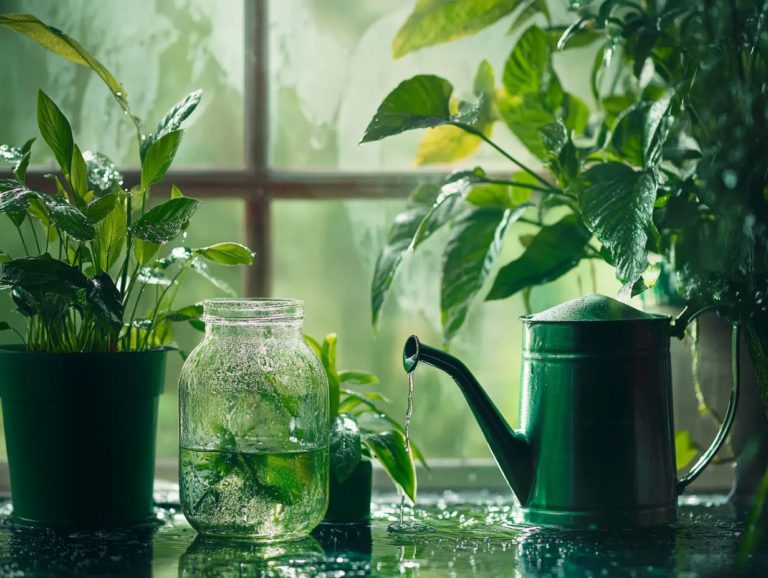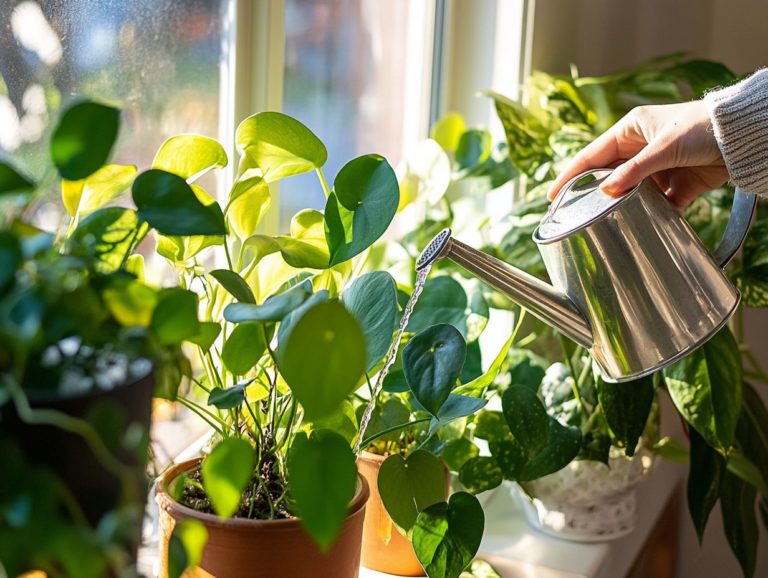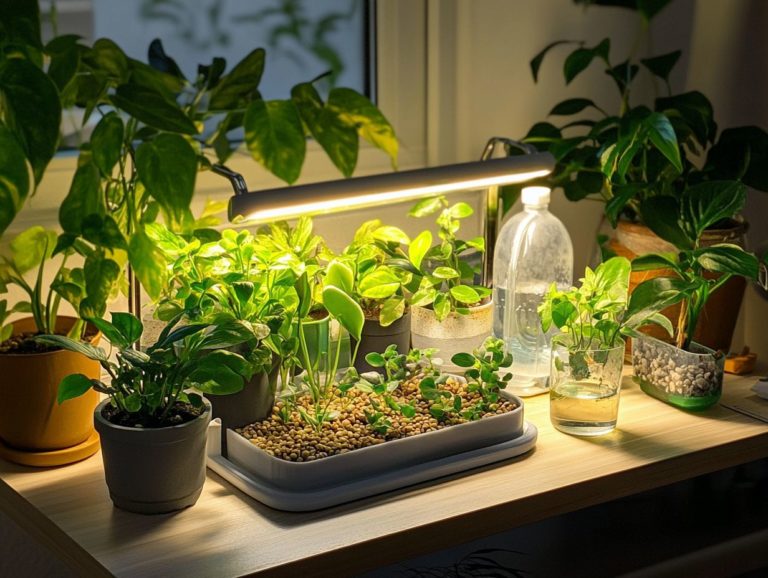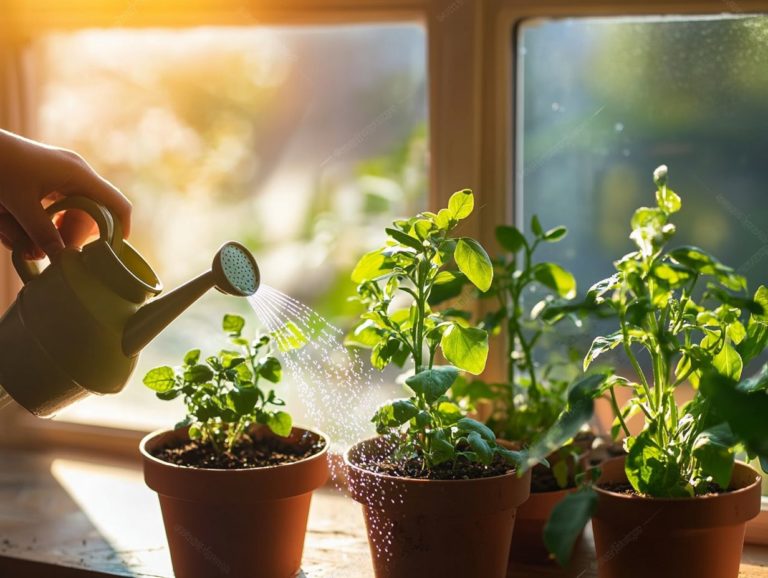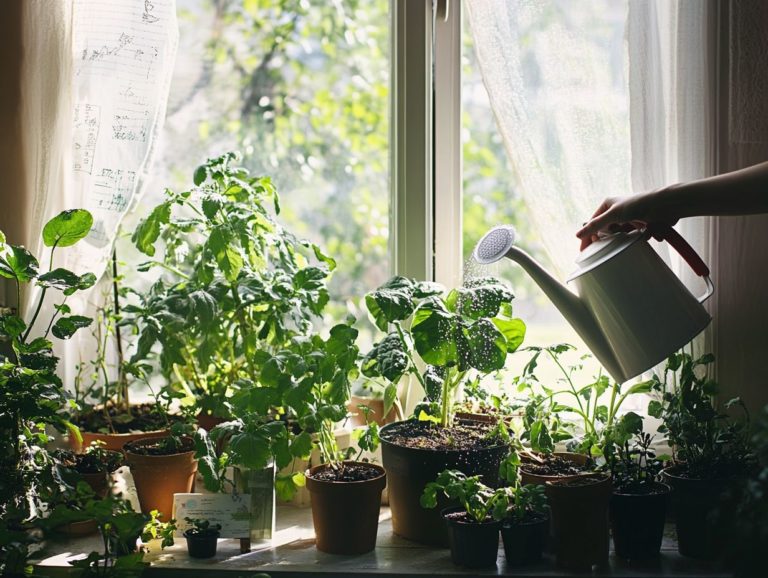Hydration Needs of Common Houseplants
Houseplants infuse your home with life and beauty. However, knowing how much water your plants need is vital for their health.
Mastering the art of watering can truly transform your plant care routine. This article delves into the significance of proper watering, teaches you how to spot signs of dehydration, and examines the various factors that impact hydration.
You ll discover best practices for watering, tailored schedules for specific plants, and innovative methods to keep your leafy companions happy and hydrated. Act now to help your houseplants not only survive but thrive!
Contents
- Key Takeaways:
- The Importance of Proper Hydration for Houseplants
- Signs of Dehydration in Houseplants
- Factors Affecting Houseplant Hydration Needs
- How to Water Houseplants
- Watering Schedule for Common Houseplants and Cacti
- Alternative Methods of Hydrating Houseplants and Improving Humidity Levels
- Your Top Questions on Houseplant Care Answered!
- What are the hydration needs of common houseplants, and how can I check them?
- How often should I water my common houseplants to avoid problems like root rot?
- What are signs that my common houseplants are not getting enough water, and how can I check?
- How do I know if I am overwatering my common houseplants, and what should I do about it?
- Are there any special considerations for watering succulents and cacti regarding their unique needs?
- Is it better to water common houseplants from the top or bottom to avoid salt buildup?
Key Takeaways:

- Proper hydration is crucial for the health and survival of houseplants. Neglecting watering needs can lead to dehydration and damage your plants.
- Signs of dehydration include wilted or yellowing leaves, dry soil, and stunted growth. Identify and address these symptoms promptly to prevent further damage.
- Factors like light, temperature, and potting medium affect the hydration needs of houseplants. Understand these factors to create the ideal environment for your plants to thrive.
The Importance of Proper Hydration for Houseplants
Proper hydration is essential for the health and growth of your houseplants. It ensures they receive the moisture needed to thrive indoors. Without the right balance of water, your indoor plants might face issues like wilting or root rot, which occurs when plant roots sit in water for too long, leading to decay.
Understanding the specific hydration needs of your houseplants is important. Factors such as humidity and temperature play critical roles in their care. Also, proper drainage is essential to prevent waterlogging, which can harm the roots.
This article helps you discover effective watering techniques, tips for avoiding common mistakes, and methods to maintain optimal moisture levels for your plants.
Why Watering Matters
Watering is a fundamental element of plant care that profoundly impacts the growth and well-being of your plants. When you water adequately, your plants absorb essential nutrients dissolved in water, promoting healthy growth and lush foliage.
If you slip into improper watering habits, like overwatering or underwatering, you may notice distress signals such as wilting or yellowing leaves. It s vital to comprehend the unique watering needs of different plant species to keep them thriving.
This balance nourishes roots and helps your plants thrive. To effectively assess a plant’s moisture levels, pay attention to indicators like soil texture and leaf condition. Overwatered plants might show droopy leaves and suffer from root rot, while those lacking moisture may develop crisp, brown edges.
Establishing a consistent watering routine involves understanding each plant s preferences. Consider grouping similar indoor plants together and adjusting watering frequencies based on seasonal changes. By implementing these tailored strategies, you can cultivate a garden that is both vibrant and resilient.
Signs of Dehydration in Houseplants
Recognizing the signs of dehydration in houseplants is essential for timely intervention and care. Common symptoms include wilting leaves, dry soil, and an overall lack of vitality in your plants.
Indoor species, particularly succulents and cacti, may display distinct signs of dehydration, like shriveling or browning edges. By understanding these indicators, you can take the right steps to restore moisture and vitality, ensuring your plants thrive beautifully.
Identifying and Addressing Symptoms
Identifying and addressing the symptoms of dehydration in your houseplants requires a keen eye and a solid understanding of their unique care needs. Common signs to look out for include:
- Dry or crispy leaves
- Droopy stems
- Soil that feels parched
To tackle these issues effectively, it s essential to ensure that your plant resides in an appropriately sized pot with proper drainage to prevent water accumulation.
Implementing effective watering practices tailored to the moisture requirements of each plant is key to restoring their health. For example, succulents, which thrive in drier conditions, will require less frequent watering than tropical plants that flourish in moist environments.
A simple tip is to check the top inch of soil for dryness; this will guide your watering schedule nicely.
If you notice a plant showing signs of stress, consider gradually rehydrating it by thoroughly soaking the soil and allowing any excess water to drain out. Using pots with drainage holes is critical to preventing root rot.
Adjusting pot sizes can further enhance drainage and improve aeration, ensuring that the roots receive the necessary moisture without becoming waterlogged.
By committing to proper maintenance and care techniques, you ll not only support your plants recovery from dehydration but also promote their long-term health and vitality.
Factors Affecting Houseplant Hydration Needs
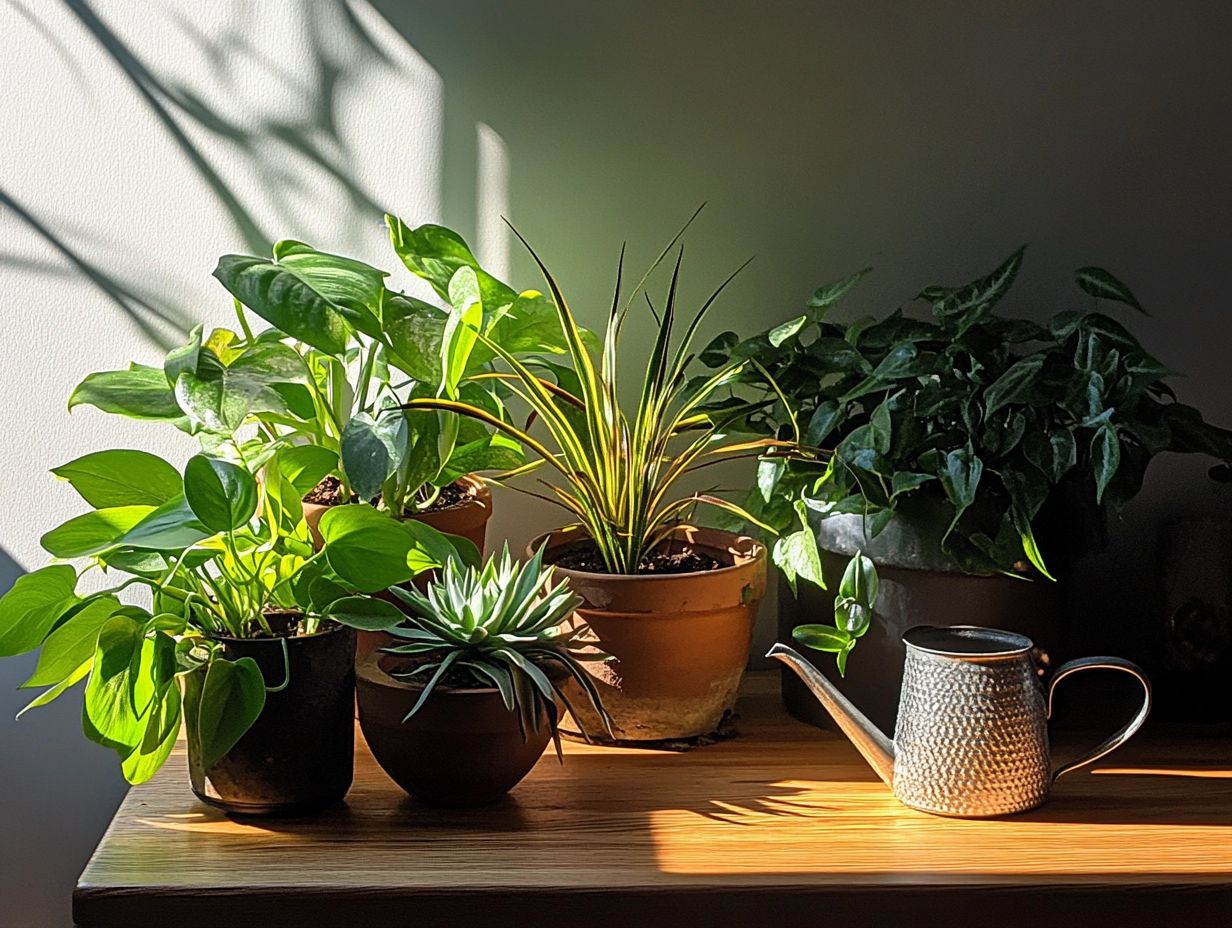
Several factors play a pivotal role in determining the hydration needs of your houseplants, directly influencing their overall health and growth.
Light intensity is particularly significant; plants basking in brighter light often require more frequent watering to sustain proper moisture levels.
The temperature and humidity in your home can also affect evaporation rates, prompting necessary adjustments to your watering schedule.
The choice of potting medium the soil mix you choose for your plants is equally important; a well-draining soil mix can help prevent overwatering while still retaining enough moisture to meet your plant’s requirements.
Light, Temperature, and Potting Medium
Getting the right balance of light, temperature, and potting medium is key to keeping your plants thriving and happy! Each plant has its own unique light preferences; some thrive in bright, indirect sunlight, while others find comfort in low-light settings.
Temperature variations can also influence how much water your plants need; warmer environments tend to increase moisture evaporation, which means you’ll need to water more frequently.
The potting medium you choose plays a significant role as well; selecting soil mixes that enhance moisture retention can greatly affect how well your plants access the water they require for optimal growth.
For example, succulents and cacti do best in bright light with well-draining soil, allowing them to thrive with less frequent watering thanks to their drought tolerance.
On the flip side, ferns prefer humid, cooler conditions with lower light, necessitating a consistent moisture level and a potting mix that holds onto water.
Tropical plants like pothos or peace lilies will flourish in a rich, moisture-retentive medium that complements their affinity for moderate temperatures.
This highlights the importance of customizing each plant s care routine to meet its specific environmental needs. By carefully observing their surroundings and making the necessary adjustments, including ensuring proper air circulation, you can ensure your green companions stay healthy and vibrant.
How to Water Houseplants
Effective watering techniques are essential for preserving the health and vitality of your houseplants. To provide the right amount of moisture, it s crucial to adopt proper watering methods tailored to their specific needs.
One useful technique is the finger test simply check the top layer of soil for dryness to determine when it s time to water.
Ensuring that your pots have adequate drainage is key; this prevents excess water from sitting at the bottom, which can lead to root rot and other complications.
Act now to perfect your watering routine and watch your plants flourish!
Best Practices for Watering
Let s dive into the best practices! Implementing effective watering techniques can truly elevate the growth and health of your houseplants. Begin by selecting the right watering technique tailored to each plant’s specific moisture needs.
For moisture-loving species, think about bottom watering, while succulents prefer to dry out thoroughly before you reintroduce water. Make it a habit to check the moisture level in the substrate regularly this will help you avoid both overwatering and underwatering. Ensure that your pots have sufficient drainage to prevent any unfortunate waterlogging.
To gauge moisture levels accurately, a soil moisture meter can be invaluable; it offers instant feedback on whether it s time to water. Alternatively, the finger test is a classic method: simply insert your finger into the soil up to the second knuckle. If it feels dry, it s definitely time to water.
Different plants have their own watering preferences. For example, ferns thrive in consistently moist environments, while cacti prefer infrequent watering.
Watering in the morning is ideal it allows plants to absorb moisture efficiently before the heat of the day sets in, maximizing hydration. By maintaining a consistent schedule tailored to each plant s unique needs, you’ll ensure optimal growth and vitality.
Watering Schedule for Common Houseplants and Cacti
Establishing a watering schedule for your common houseplants is crucial for meeting their hydration needs and fostering healthy growth. Think about factors like plant type, pot size, and environmental conditions. Humidity and temperature all play a significant role in determining how often and how much to water.
For instance, succulents typically require less frequent watering than tropical plants, which flourish in more humid settings. By customizing your watering routine to fit the unique needs of your plants, you can ensure optimal hydration and avoid problems related to overwatering or underwatering. Understanding the science of watering indoor plants can further enhance your plant care strategies.
Recommended Frequency, Amount, and Soil Quality
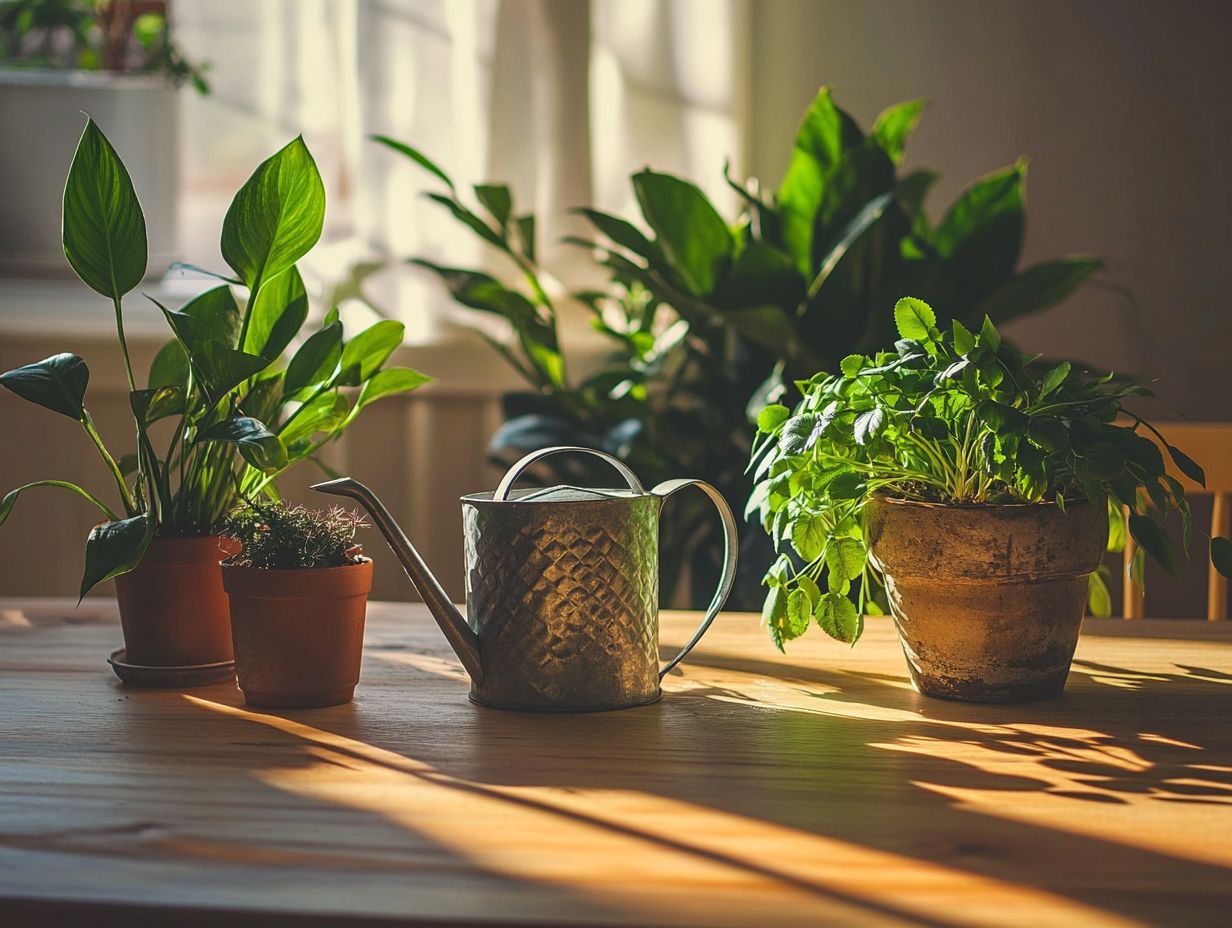
Finding the right watering frequency and amount is key to the health of your houseplants. As a rule of thumb, water when the top inch of soil feels dry, but remember that this varies widely among different species and depends on your soil mix quality.
For example, succulents may only need watering every two weeks, while tropical plants often require hydration once a week to maintain the perfect moisture balance. It’s also crucial to adjust the amount of water based on pot size and drainage capabilities to prevent waterlogged roots and encourage robust growth. For more detailed guidance, check out the best watering schedule for common plants.
Cacti, meanwhile, thrive on a more unpredictable watering schedule, typically needing a good soak about once a month during their growing season. To fine-tune your approach, using a moisture meter can be a game-changer, giving you a precise indication of when it s time to water while considering factors like drainage and air circulation.
Pay attention to signs like wilting or yellowing leaves they’re your plants’ way of communicating when something’s amiss and may indicate issues like overwatering or underwatering. With a little mindfulness regarding each plant s unique needs, you can cultivate a vibrant indoor garden that flourishes through every season.
Alternative Methods of Hydrating Houseplants and Improving Humidity Levels
Exploring alternative methods of hydrating your houseplants opens up a world of unique solutions for maintaining optimal moisture levels. Beyond the usual watering routine, techniques like misting can enhance humidity around your plants, making it a great place for those that love moisture.
Using moisture meters helps you gauge the soil’s hydration levels precisely, ensuring your plants receive just the right amount of water while avoiding the pitfalls of overwatering, which can lead to root rot. These methods not only complement traditional watering practices but also cater to the individual needs of your various plant companions.
Other Ways to Provide Moisture and Enhance Air Circulation
You have many exciting ways to keep your plants happy! You can provide moisture for your houseplants and enhance their hydration without relying solely on traditional watering methods, which may not suffice for all conditions.
One effective technique is misting. This involves spraying water onto the leaves to boost humidity, which is particularly beneficial for tropical plants that thrive in moist environments. This method caters to the hydration needs of plants like ferns and orchids. It also acts as a natural deterrent against pests that prefer drier conditions, thereby enhancing your indoor garden. For more tips on optimizing your watering practices, check out our guide on maximizing water efficiency for your houseplants.
Another smart strategy is using a moisture meter, a tool that tells you how wet the soil is. This handy device accurately measures the soil’s moisture content, enabling you to make informed watering decisions tailored to the specific needs of your plant species. This helps prevent issues like salt buildup and ensures optimum nutrient availability.
If you re nurturing succulents or cacti, understanding their unique hydration requirements is key to preventing overwatering and root rot. By incorporating these strategies, along with proper potting techniques, you can foster thriving greenery and create a more vibrant indoor ecosystem.
Your Top Questions on Houseplant Care Answered!
What are the hydration needs of common houseplants, and how can I check them?
The hydration needs of common houseplants vary depending on the type of plant and pot sizes. Generally, they require regular watering to maintain healthy growth and prevent wilting.
How often should I water my common houseplants to avoid problems like root rot?
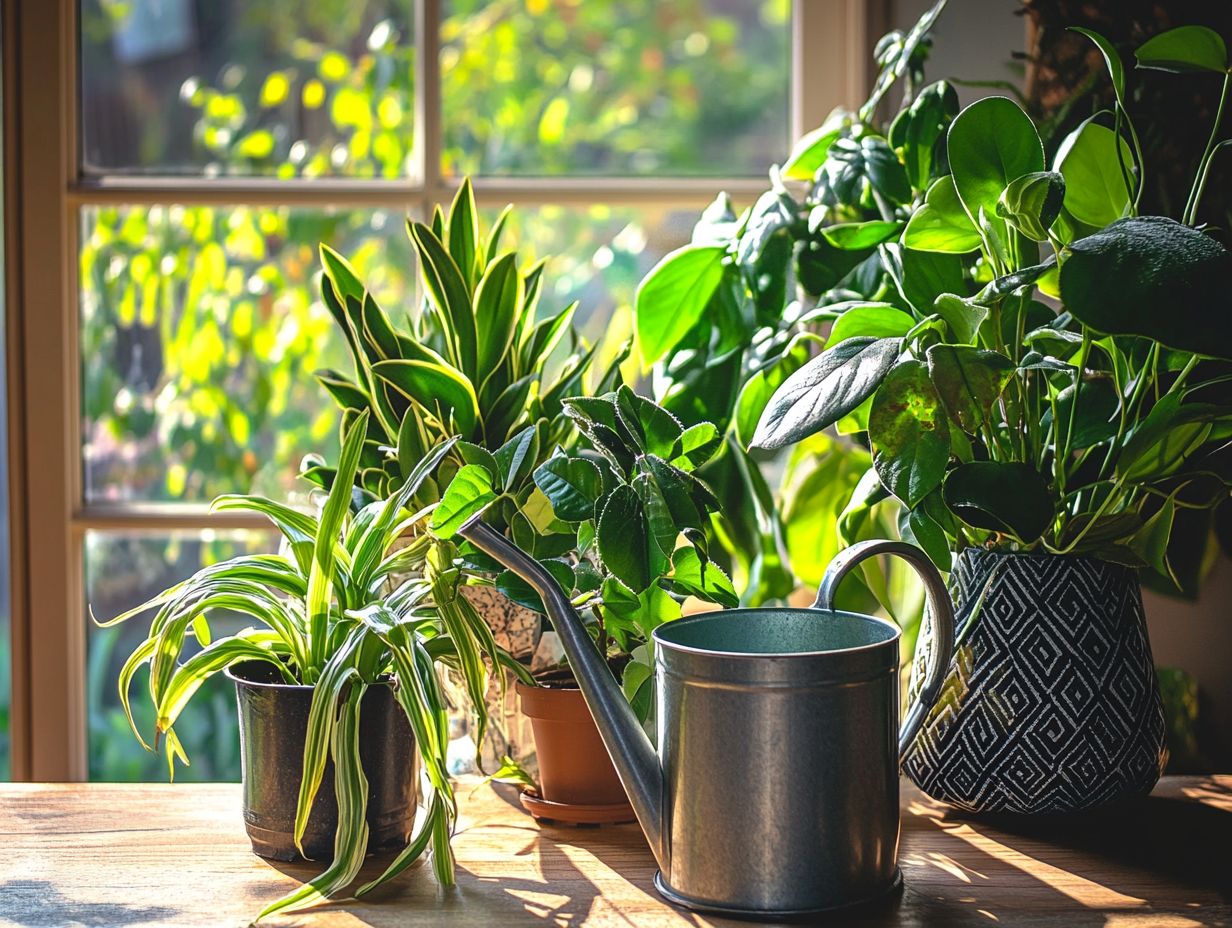
The frequency of watering for common houseplants depends on factors like the type of plant, the size of the pot, and the amount of light and humidity in your home. As a general rule, most houseplants should be watered once or twice a week, while keeping an eye out for symptoms of overwatering.
What are signs that my common houseplants are not getting enough water, and how can I check?
If the leaves of your houseplants are wilting or turning yellow, this indicates they are not getting enough water. You might also notice dry, crispy edges on the leaves or a dry, compact soil surface. Regularly checking the soil moisture with your finger test can help avoid these issues.
How do I know if I am overwatering my common houseplants, and what should I do about it?
Overwatering can be just as harmful as underwatering. Signs of overwatering include yellowing or droopy leaves, moldy soil, or a foul odor. To prevent overwatering, check the soil moisture before watering and adjust the frequency accordingly, ensuring proper drainage.
Are there any special considerations for watering succulents and cacti regarding their unique needs?
Succulents and cacti have different hydration needs compared to other houseplants. They require less frequent watering, usually once a week or every other week, and the soil should be allowed to dry out completely between waterings to prevent root rot.
Is it better to water common houseplants from the top or bottom to avoid salt buildup?
It is generally recommended to water from the top, as this allows the water to reach all parts of the soil and flush out any excess salts or minerals. However, bottom watering can also be effective for certain plants, especially those with delicate foliage that may be damaged by water droplets. This ensures a balanced approach to hydration.


